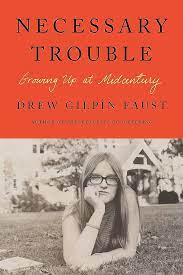Author: Drew Gilpin Faust
Publication: Farrar Straus & Giroux, hardcover, 2023
Genre: Nonfiction/MemoirOnce upon a time, there was a little girl. Her official name was Catharine, but she never used it. Her father, though from a wealthy Ivy League background, wanted only to breed horses, so that was what he did. The girl grew up in rural, segregated Virginia in the fifties, reading Nancy Drew and pony books, riding horses, raising steers with the 4H Club, attending a small country school.
Would you be surprised to learn that she would become the president of Harvard? In her absorbing memoir, Drew Gilpin Faust tells how she became aware of the troubled outside world and set out to fix it.
It began when she realized, at the age of nine, that there were Black children in her neighborhood who had no access to good schooling. The Supreme Court had already made its ruling, but the effect, as we know, was delayed. What did she do about it? She wrote a letter to President Eisenhower (it’s in the Eisenhower Presidential Library) urging him, “Please try and have schools and other things accept colored people.” When she was 13, she left home for Concord Academy, a progressive girls’ school in Massachusetts. The one thing she fails to explain is why her family, which was not supportive of her viewpoints, chose this school for her. It was a perfect fit.
Not quite 16, she did a summer trip, with a small group of students and two Quaker-affiliated leaders, to East Germany, Czechoslovakia and Yugoslavia, seeing for herself what life was like under Soviet rule. Then, while at Bryn Mawr College, she became such an activist it’s a wonder she got any work done – traveling to Mississippi in the wake of the Freedom Summer, taking part in anti-Vietnam-war demonstrations in Washington, missing deadlines to join the Selma march.
She ends the story with her graduation from college, leaving the reader to fill in her PhD and celebrated career as a historian of the Civil War period, and then as the first woman president of the nation’s oldest university. But we have learned enough from her account that it seems almost inevitable.This is a very readable and interesting book, including the chapters on her family, on life in the fifties, on her own social and intellectual growth. She notes the times when her young self was naïve and uninformed, but we see how fast she learned.
Genre: Nonfiction/MemoirOnce upon a time, there was a little girl. Her official name was Catharine, but she never used it. Her father, though from a wealthy Ivy League background, wanted only to breed horses, so that was what he did. The girl grew up in rural, segregated Virginia in the fifties, reading Nancy Drew and pony books, riding horses, raising steers with the 4H Club, attending a small country school.
Would you be surprised to learn that she would become the president of Harvard? In her absorbing memoir, Drew Gilpin Faust tells how she became aware of the troubled outside world and set out to fix it.
It began when she realized, at the age of nine, that there were Black children in her neighborhood who had no access to good schooling. The Supreme Court had already made its ruling, but the effect, as we know, was delayed. What did she do about it? She wrote a letter to President Eisenhower (it’s in the Eisenhower Presidential Library) urging him, “Please try and have schools and other things accept colored people.” When she was 13, she left home for Concord Academy, a progressive girls’ school in Massachusetts. The one thing she fails to explain is why her family, which was not supportive of her viewpoints, chose this school for her. It was a perfect fit.
Not quite 16, she did a summer trip, with a small group of students and two Quaker-affiliated leaders, to East Germany, Czechoslovakia and Yugoslavia, seeing for herself what life was like under Soviet rule. Then, while at Bryn Mawr College, she became such an activist it’s a wonder she got any work done – traveling to Mississippi in the wake of the Freedom Summer, taking part in anti-Vietnam-war demonstrations in Washington, missing deadlines to join the Selma march.
She ends the story with her graduation from college, leaving the reader to fill in her PhD and celebrated career as a historian of the Civil War period, and then as the first woman president of the nation’s oldest university. But we have learned enough from her account that it seems almost inevitable.This is a very readable and interesting book, including the chapters on her family, on life in the fifties, on her own social and intellectual growth. She notes the times when her young self was naïve and uninformed, but we see how fast she learned.
_ _ _ _ _ _ _ _ _
Thank you to Stephanie Martin for the guest review! I enjoyed this too and look forward to the sequel.
Photo credit to Harvard University.



I am really looking forward to reading this one. I was pleasantly surprised to find a sizeable waiting list already at the library.
ReplyDeleteThis one sounds fascinating! When you mentioned Brynn Mawr college I thought you meant Wales and when I looked it up it is indeed a town in Wales as I thought. But the college is in Pennsylvania. Any idea how that happened? Founded by a Welsh person maybe?
ReplyDeleteApparently, the gentleman who named the Pennsylvania town where the college is located had come from Wales where his home was called Bryn Mawr. He was an associate of William Penn. The college is all women and very prestigious.
ReplyDeleteThis sounds absolutely great!!
ReplyDeleteI do think that book would be an interesting read. Especially since she is about one year older than I am. Born in different states and different economic circumstances.
ReplyDelete